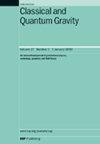Limits on the existence of totally reflective exotic compact objects with current and future gravitational-wave detectors
IF 3.6
3区 物理与天体物理
Q2 ASTRONOMY & ASTROPHYSICS
引用次数: 0
Abstract
Exotic compact objects (ECOs) are a theorized class of compact objects that solve the paradoxes of black holes by replacing the event horizon with a physical surface located at from the would-be horizon at . Spinning horizonless objects are prone to the ergoregion instability, which would prevent their existence if their spin is higher than a critical threshold. In this paper, we set upper limits on the existence of a population of merging ECOs from the spin distribution of the population of compact binary coalescences (CBCs) detected by the LIGO, Virgo and KAGRA collaboration. Using spin measurements from 104 compact objects, we find that if ECOs have and their surface is totally reflective, the population of CBCs cannot be composed (at 90% credible level) by more than 71% (59%) of ECOs for polar (axial) perturbations. If we restrict the ECOs to be ultracompact ( ), at 90% credible level, ECOs cannot compose more than 28% and 25% of the CBC population for polar and axial perturbations. The constraints from current data are a factor of two more precise than the ones obtained from a non-detection of a stochastic GW background due to spin loss. We also study how next generation gravitational-wave detectors, such as the Einstein Telescope, can constrain the ECO population. We find that 1 day of data taking would be enough to constrain the fraction of ECOs to be lower than 20% for .用当前和未来的引力波探测器对完全反射的奇异致密天体存在的限制
奇异紧致物体(ECOs)是一种理论化的紧致物体,它通过用位于视界的物理表面取代视界来解决黑洞的悖论。旋转的无水平物体容易产生自旋区域不稳定性,当其自旋高于临界阈值时,这种不稳定性将使其无法存在。本文根据LIGO、Virgo和KAGRA合作探测到的紧致双聚结(cbc)的自旋分布,给出了合并eco居群存在的上限。通过对104个致密天体的自旋测量,我们发现如果eco具有并且它们的表面是完全反射的,那么在极性(轴向)扰动下,超过71%(59%)的eco不可能构成CBCs的种群(在90%可信水平上)。如果我们将eco限制为超紧凑(),在90%可信水平下,eco在极性和轴向扰动下不能超过CBC种群的28%和25%。来自当前数据的约束比由于自旋损失而没有检测到随机GW背景的约束要精确两个因素。我们还研究了下一代引力波探测器,如爱因斯坦望远镜,如何约束ECO种群。我们发现,1天的数据采集足以将eco的比例限制在20%以下。
本文章由计算机程序翻译,如有差异,请以英文原文为准。
求助全文
约1分钟内获得全文
求助全文
来源期刊

Classical and Quantum Gravity
物理-天文与天体物理
CiteScore
7.00
自引率
8.60%
发文量
301
审稿时长
2-4 weeks
期刊介绍:
Classical and Quantum Gravity is an established journal for physicists, mathematicians and cosmologists in the fields of gravitation and the theory of spacetime. The journal is now the acknowledged world leader in classical relativity and all areas of quantum gravity.
 求助内容:
求助内容: 应助结果提醒方式:
应助结果提醒方式:


